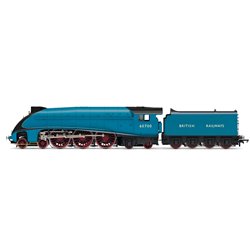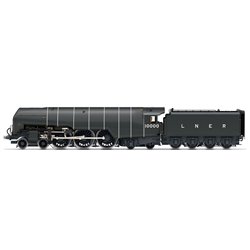Static grass puffer bottles work by manually charging model grass fibres with static electricity. When the charged...
No products
Product successfully added to your shopping cart
There are 0 items in your cart. There is 1 item in your cart.
Search Tips
What was the Hush Hush locomotive?
The Hush Hush locomotive, formally known as the W1 No. 10000, was a groundbreaking experimental steam engine developed by the London and North Eastern Railway (LNER) in the late 1920s. It earned its nickname, "Hush Hush", due to the high level of secrecy surrounding its design and development, as well as its unconventional features. Sir Nigel Gresley, the renowned Chief Mechanical Engineer of the LNER, was the mastermind behind the project. He envisioned the locomotive as a testbed for advanced steam technology, aiming to increase power and efficiency to keep up with the growing demand for high-speed rail travel.
The most distinctive feature of the Hush Hush locomotive was its water-tube boiler. Unlike traditional fire-tube boilers, where water surrounds the tubes that carry hot gases, in a water-tube boiler, water flows through the tubes which are surrounded by hot gases. This design was intended to increase the engine’s steam-generating capacity and efficiency, enabling it to handle longer, heavier trains at higher speeds. Water-tube boilers had been successfully used in marine applications, but this was the first time such a boiler was implemented on a mainline railway locomotive in Britain.
The W1 locomotive was an imposing sight, originally appearing with an unstreamlined, boxy appearance, earning it the additional nickname "The Galloping Sausage". However, its performance was mixed. Although it was capable of high speeds and hauling heavy loads, the water-tube boiler proved to be problematic. It was prone to leaks and difficult to maintain, and the anticipated improvements in efficiency did not materialise as hoped. After several years of testing, the LNER decided to abandon the water-tube boiler concept.
In 1937, the W1 underwent a significant transformation, with the original water-tube boiler being replaced by a conventional fire-tube boiler. It was also streamlined to match the sleek appearance of Gresley’s A4 Pacific locomotives, which had become famous for their speed and aerodynamic design. This transformation gave the W1 a new lease of life, allowing it to serve more effectively on the East Coast Main Line for the remainder of its working life, though it never reached the fame or success of the A4s.
Despite its experimental nature and the mixed results of its innovations, the Hush Hush locomotive holds a special place in British railway history. It represents a bold attempt to push the boundaries of steam technology during a period when railways were seeking to maintain their dominance in long-distance travel. Its unusual design and the aura of mystery surrounding its development captured the imagination of railway enthusiasts.
The locomotive was withdrawn from service in 1959 and subsequently scrapped, as was common practice at the time. However, its legacy lives on through model reproductions and the continuing interest from historians and railway modellers, who regard the Hush Hush as an intriguing chapter in the evolution of British steam locomotion. Although it did not achieve the success initially hoped for, it remains a testament to the spirit of experimentation and innovation that characterised British engineering during the golden age of steam.
Click here to receive the tips weekly in your mailbox. You can unsubscribe at any time.









